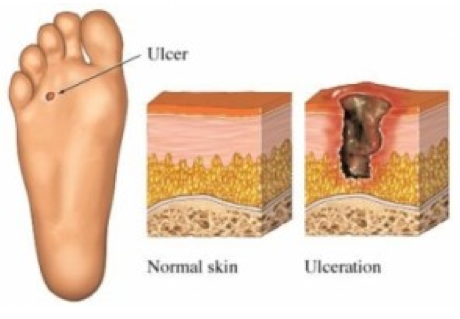First of all, I am not a doctor, I have no direct knowledge of diabetic foot infections, and this is not medical advice. Be sure to talk to your doctor before making any medical decisions or beginning or discontinuing any treatment. With that said, hopefully you find this article on the dangers of foot infections for people with diabetics helpful and informative.
The pathophysiology of degenerative changes in the foot occurrence in diabetic patients is complex. However, the treatment of infected diabetic foot is relatively common and serious problem. Foot amputation is 15 times more likely in diabetic patients than in the general population.
Often, it is difficult to distinguish between ulcers that are infected and those that are not. Signs of infection include redness around the ulcer, fertilizing bottom ulcers, crepitation surrounding tissue, and purulent secreting fistula.
Diabetic Foot Infections
Practically, diabetic foot infections are divided into two groups:
1) infections that do not compromise the foot and
2) infections that threaten the foot.
1) Infections that do not compromise the foot are superficial infection without systemic manifestations, with signs of cellulitis less than 2 cm around the entry point (ulcers) and no signs of grasping the bones and joints. If an ulcer is present, it does not extend to the entire thickness of the skin.
Therapeutic recommendations: clindamycin, cloxacillin, co-amoxiclav, or cephalexin (all as monotherapy). Possible oral administration of these antibiotics. There are also recommendations for use of fluorinated quinolones, not as direct therapy, but on the basis of isolating susceptible bacteria.
2) Infections that threaten the foot are deep, with general symptoms, and with signs of grasping the bones and joints or purulent collections (eg, plantar abscess). If there is an ulcer, it involves the entire thickness of the skin, and the area of cellulitis around it is larger than 2 cm. There are also signs of lymphangitis.
Therapy
In these situations, the patient is usually hospitalized and the therapy includes:
– Clindamycin + gentamicin or
– Ciprofloxacin
– Co-amoxiclav with or without aminoglycosides
– Clindamycin + third generation cephalosporins
– Clindamycin + ciprofloxacin
The use of imipenem and vancomycin is usually recommended in life-threatening infections. The shortest duration of treatment is 14 days.
Prevention
Feet Examination
Examine your feet daily and immediately report any problem to your doctor. Examine whether there are any wounds or any change in skin and nails. Use a mirror to see the entire foot. If you have diabetes, it is important to have your feet examined regularly by your doctor.
Soaking
In general, people with diabetes should not soak their feet. However, occasionally using a foot spa with care is ok. As Diabetes UK (PDF link) reports,
People with diabetes can also use foot spas with care. Check the temperature
of the water to make sure it’s not too hot before you put your feet in. However, if you have been told by your podiatrist, nurse or doctor that you have nerve damage to your feet then don’t use foot spas at all.
So, if you’re looking for the best home foot spa for at home, check out this list.
Foot Massage
Massaging your feet and lower legs after washing and drying the feet can have a very beneficial effect on blood circulation in the legs. During the massage using neutral vegetable oils and skin creams, or ethyl alcohol is recommended. Gently massage the soles and instep. Areas between the toes are not massaged. Massage has the best effects on the muscles of the lower leg. It reduces pain in the lower leg and foot numbness.
Do not use anti-rheumatic creams because that could damage the skin and lead to infection. Patients with varicose veins should not be massaged on the leg because of the risk of embolism.
For more information on the challenges of foot care for people with diabetes, check out this article in the Pittsburgh Post-Gazette.

